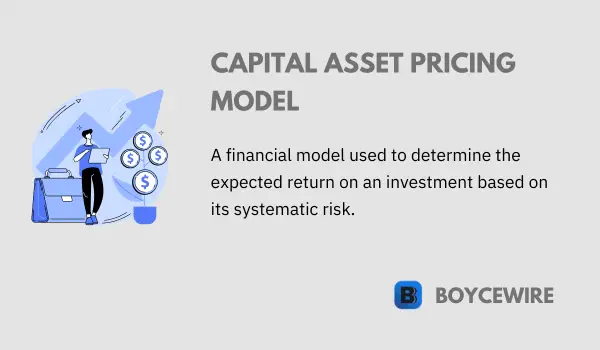Capital Asset Pricing Model: Definition, Formula & Examples

What is the Capital Asset Pricing Model?
The realm of finance is replete with models and theories that strive to illuminate the complexities of markets, risk, and returns. Among these, the Capital Asset Pricing Model (CAPM), with its profound simplicity and significant insights, stands out. Conceived in the mid-20th century, CAPM offers an analytical framework that connects the risk associated with a particular investment to its expected return. It serves as a cornerstone in the world of finance, guiding critical decisions pertaining to investment analysis, portfolio management, and corporate finance.
Key Points
- The Capital Asset Pricing Model (CAPM) is a financial model used to estimate the expected return on an investment based on its risk.
- It assumes that investors are rational and risk-averse, markets are efficient, and all investors have the same expectations about future returns and risks.
- The CAPM calculates the expected return by considering the risk-free rate of return, the asset’s beta (systematic risk), and the market risk premium.
Foundations of CAPM
The Capital Asset Pricing Model (CAPM) finds its roots in the fundamental concepts of modern portfolio theory, efficient frontier, and the relationship between risk and return.
1. Introduction to Modern Portfolio Theory
Modern Portfolio Theory (MPT), introduced by Harry Markowitz in 1952, provides the backdrop against which CAPM was developed. MPT proposes that investors can construct an ‘efficient’ portfolio to maximize expected returns for a given level of risk by diversifying their investments. It emphasizes that the risk and return of a portfolio depend not just on individual asset characteristics, but also on how assets are correlated with each other.
2. Concept of Efficient Frontier
Within MPT, the Efficient Frontier represents a set of optimal portfolios that offer the highest expected return for a defined level of risk. Each point on the frontier represents a distinct portfolio structure that has maximized returns for a given level of risk. The concept of the efficient frontier underpins CAPM by providing the groundwork for understanding the trade-off between risk and return.
3. Understanding Risk and Return
Central to CAPM is the notion that a rational investor expects higher returns for taking on higher risk. In this context, risk refers specifically to systematic risk (or market risk) that cannot be eliminated through diversification. This risk-return relationship is quantified through the model, with the premium demanded for riskier investments represented as a linear relationship with the degree of systematic risk. Thus, the theoretical underpinnings of CAPM lie in the understanding of risk and its relation to expected return, as established in modern portfolio theory.
Components of CAPM
The Capital Asset Pricing Model (CAPM) is constructed around three primary components: the risk-free rate, beta (representing systematic risk), and the expected market return. These elements interact to determine an investment’s expected return.
1. Risk-Free Rate
The risk-free rate denotes the return on an investment with zero risk. It represents the minimum return an investor would expect for any investment because they could alternatively just hold the risk-free asset. Typically, this is represented by the yield on a long-term government bond, given the perception of minimal risk associated with such investments.
2. Beta (Systematic Risk)
Beta is a measure of an investment’s systematic risk or the risk that cannot be diversified away. It indicates the sensitivity of the investment’s returns to movements in the overall market. An asset with a beta of 1 is expected to move in line with the market. If the beta is greater than 1, the asset is considered more volatile than the market, and if it’s less than 1, it is less volatile.
3. Expected Market Return
The expected market return is the anticipated return from the overall market portfolio. It is usually estimated based on historical returns. The difference between the expected market return and the risk-free rate is known as the market risk premium, which represents the return that investors expect in exchange for bearing the risk of the market as a whole.
4. Market Risk Premium
The market risk premium, a key component in the CAPM formula, signifies the excess return that a diversified market portfolio provides over the risk-free rate. It is a reward to investors for bearing market risk. This premium varies across time and is dependent on prevailing market conditions and investor sentiment.
CAPM Formula and Calculation
The Capital Asset Pricing Model (CAPM) is encapsulated in a formula that links the expected return of an investment to its systematic risk. Here, we’ll present the CAPM formula and guide you through its calculation using an example scenario.
1. Presentation of the CAPM Formula
The CAPM formula is as follows:
Expected Return = Risk-Free Rate + Beta * (Expected Market Return – Risk-Free Rate)
In this equation, the term (Expected Market Return – Risk-Free Rate) is known as the Market Risk Premium.
2. Step-by-step Explanation of a CAPM Calculation
Let’s break down the CAPM calculation into step-by-step instructions.
- Identify the risk-free rate: This is usually the yield on a long-term government bond.
- Identify the beta of the investment: This can be computed based on historical data or sourced from financial databases.
- Identify the expected market return: This is often derived from historical market returns.
- Calculate the market risk premium: Subtract the risk-free rate from the expected market return.
- Insert these values into the CAPM formula to find the expected return.
3. Example Scenario of Applying CAPM
Assume the risk-free rate is 2%, the beta of the investment is 1.5, and the expected market return is 8%.
The market risk premium would be 8% – 2% = 6%.
Using the CAPM formula, we would find:
Expected Return = 2% + 1.5 * 6% = 11%
This suggests that, given its level of systematic risk, we would expect an 11% return from the investment to compensate for the risk we are taking. This forms the basis for investment decision-making under CAPM, providing investors with a means of evaluating potential investments in the context of their risk and return profiles.
Assumptions and Limitations of CAPM
While the Capital Asset Pricing Model (CAPM) offers a theoretically compelling framework for estimating expected returns based on risk, it is built on several assumptions that may not hold in reality. Here, we explore the key assumptions, their implications, and the related criticisms of CAPM.
1. Assumptions of CAPM
- Investors are rational and risk-averse: CAPM assumes that all investors aim to maximize their portfolios’ expected return for a given level of risk. It also assumes that investors are risk-averse, preferring a certain return over an uncertain one with the same expected value.
- Single-period transaction horizon The model assumes that investors plan for the same single-period investment horizon, which may not be accurate in reality as different investors may have different investment horizons.
- Perfect capital markets CAPM assumes no taxes, no transaction costs, and unrestricted borrowing and lending at the risk-free rate. Investors can buy any fraction of an asset, and there are no restrictions on short selling. These assumptions simplify the model but do not align with real-world market conditions.
- All assets are marketable and information is freely available The model presupposes that all assets can be traded in markets, and all relevant information is freely available to all investors, leading to efficient markets. This may not always be the case, especially in emerging markets.
- Beta remains constant The CAPM assumes that the beta of a security, which measures its systematic risk, remains constant over time. In reality, beta can change due to alterations in a company’s financial structure, changes in its business risk, or shifts in the economy.
2. Criticisms of CAPM
Given the assumptions of CAPM, various criticisms have been leveled against it.
- Unrealistic assumptions The assumptions of perfect markets and rational behavior are far from the reality of imperfect markets, transaction costs, taxation, and the sometimes irrational behavior of investors.
- Inaccurate measure of systematic risk Critics argue that beta, as a measure of systematic risk, may not fully capture the complexity of a security’s risk profile.
- Over-reliance on past data CAPM relies heavily on historical market returns and asset prices to calculate beta and expected market returns. This backward-looking approach may not accurately forecast future performance.
- Limited explanatory power Empirical studies have shown that other factors, such as company size and book-to-market ratios, may better explain differences in asset returns, a concept explored in models like the Fama-French Three-Factor model.
Despite these limitations and criticisms, CAPM continues to be widely used due to its simplicity and the intuitive appeal of its underlying principles. However, recognizing its limitations is crucial for its informed application in financial analysis and decision-making.
Applications of CAPM
Despite the criticisms and limitations, the Capital Asset Pricing Model (CAPM) has widespread applications in various spheres of finance due to its ability to quantify and link risk and return. The following sections will detail how CAPM is used in portfolio management, investment analysis, and corporate finance.
1. Portfolio Management and Investment Analysis
CAPM plays a pivotal role in portfolio management. It helps in the construction of an optimal portfolio by calculating the expected returns of various assets based on their systematic risk. The model enables investors to estimate the return they should expect from an investment, considering its risk relative to the overall market. Thus, it provides a framework for making informed decisions about which assets to include in a portfolio to maximize return for a given level of risk.
2. Corporate Finance and Capital Budgeting
CAPM’s influence extends to corporate finance, especially in the realm of capital budgeting. Companies often use CAPM to calculate the cost of equity capital, which is integral in determining a project’s discount rate in net present value (NPV) analyses. By using CAPM, firms can make risk-adjusted evaluations of different investment projects, which helps in making decisions about project funding and capital allocation.
3. Case Studies Illustrating the Use of CAPM
Let’s look at some real-world applications of CAPM. For instance, large corporations like ExxonMobil or Microsoft might use CAPM to estimate the required return on new projects relative to their risk. Financial advisors and fund managers could use the model to identify overpriced or underpriced securities, informing their buy or sell decisions. Even regulatory authorities employ CAPM, such as when utility regulators set allowed rates of return based on the risk of the utility’s operations.
Though CAPM is not without its critics, its simplicity and intuitive grounding in the risk-return trade-off ensure its continued relevance in financial theory and practice. It serves as a fundamental tool for understanding investment risk and shaping effective financial strategies.
Examples of CAPM
Let’s delve into a couple of examples to illustrate how the Capital Asset Pricing Model (CAPM) might be applied in real-world situations.
1. Evaluating Investment in a Tech Startup
Imagine that you’re considering an investment in a technology startup. The startup has a beta of 1.8, indicating a high level of systematic risk due to the uncertain nature of the tech industry. The current risk-free rate is 2%, and the expected market return is 8%.
Using CAPM, the expected return on your investment would be:
Expected Return = Risk-Free Rate + Beta * (Expected Market Return – Risk-Free Rate)
= 2% + 1.8 * (8% – 2%)
= 12.8%
Given the high level of risk (as indicated by the high beta), the CAPM suggests that you should expect a return of 12.8% on your investment to compensate for the risk you’re taking.
2. Determining the Cost of Equity in Corporate Finance
Consider a large corporation, like Microsoft, contemplating a new project. To calculate the cost of equity, Microsoft might use CAPM. Suppose Microsoft’s beta is 1.05, the risk-free rate is 2%, and the expected market return is 8%.
Using CAPM, Microsoft’s cost of equity would be:
Cost of Equity = Risk-Free Rate + Beta * (Expected Market Return – Risk-Free Rate)
= 2% + 1.05 * (8% – 2%)
= 8.3%
Therefore, if Microsoft’s new project doesn’t anticipate a return of at least 8.3%, the firm may decide to pass on the project because it wouldn’t meet their required return for the level of risk.
These examples demonstrate how CAPM can be a practical tool in both personal investment decisions and corporate finance by linking the expected return of an investment to its level of systematic risk.
FAQs
The Capital Asset Pricing Model (CAPM) is a financial model used to determine the expected return on an investment based on its risk compared to the overall market.
The CAPM calculates the expected return of an asset by considering its beta, which measures its sensitivity to market movements, and the risk-free rate of return.
Beta represents the systematic risk of an asset and measures how its returns move in relation to the overall market.
The risk-free rate of return is typically based on the yield of government bonds, as they are considered to have negligible default risk.
About Paul
Paul Boyce is an economics editor with over 10 years experience in the industry. Currently working as a consultant within the financial services sector, Paul is the CEO and chief editor of BoyceWire. He has written publications for FEE, the Mises Institute, and many others.

Further Reading
 Mixed Economy: Definition, Pros, Cons & Examples - A mixed economy is an economic system that combines elements of a capitalist, market-based system, with a socialist, command economy…
Mixed Economy: Definition, Pros, Cons & Examples - A mixed economy is an economic system that combines elements of a capitalist, market-based system, with a socialist, command economy…  EBITDA: Definition, Pros, Cons & Example - EBITDA stands for Earnings Before Interest, Tax, Depreciation, and Amortization.
EBITDA: Definition, Pros, Cons & Example - EBITDA stands for Earnings Before Interest, Tax, Depreciation, and Amortization.  Consumerism - Consumerism is a socio-economic ideology that promotes the acquisition and consumption of goods and services as a measure of individual…
Consumerism - Consumerism is a socio-economic ideology that promotes the acquisition and consumption of goods and services as a measure of individual… 